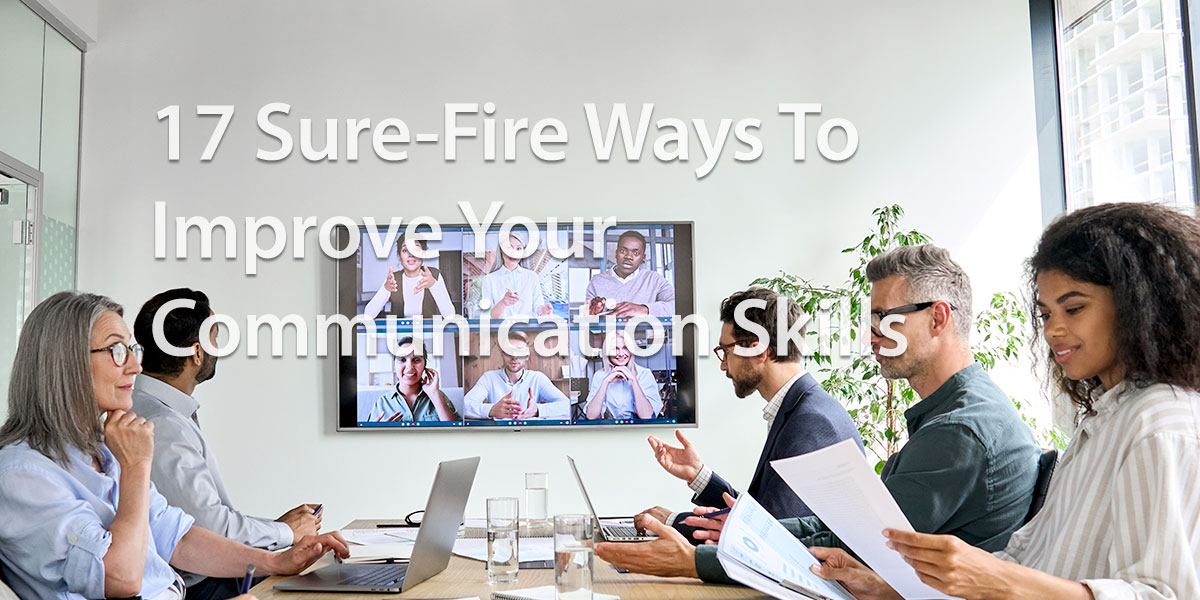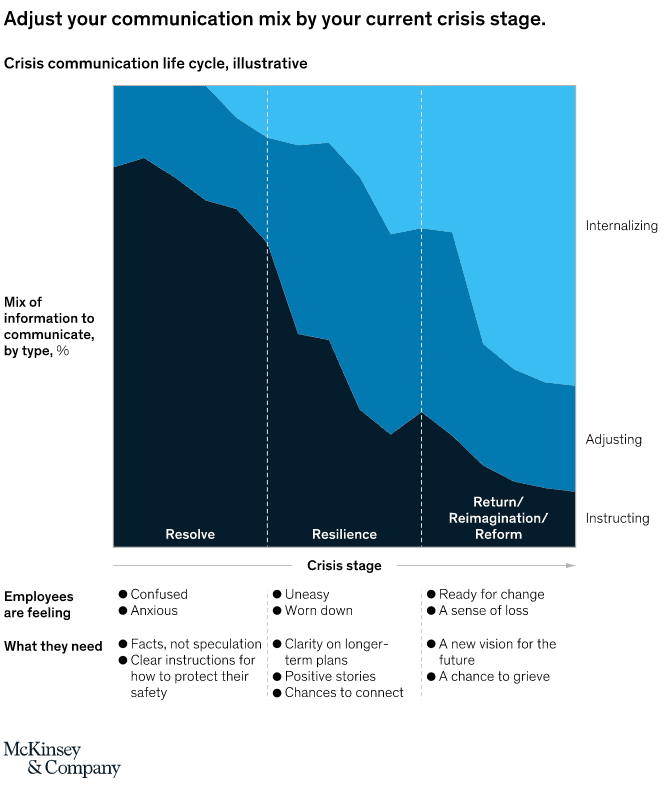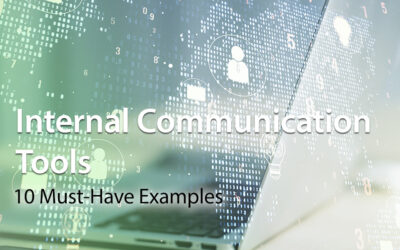Get corporate communication right, and your company thrives. Get it wrong, and you could fail. Although it’s one of the main driving forces behind success, many organizations take it for granted. Comms are often done on the hoof without much coordination across internal and external messaging. This article is essential reading if you are a comms professional, CEO, or a small business owner. We give the latest lowdown on corporate communication. All your questions are answered, so you can take a fresh look at company comms and check you are on track.
What Is Meant By Corporate Communication?
Basically, it describes all the messages and information sharing taking place within an organization. This includes both internal and external audiences.
There are three main ways to deliver corporate comms:
- Written communications: Included here are website content, ad copy, newsletters, tweets or social media posts, reports, and emails
- Visual comms: Think images, logos, branding, infographics, and presentations
- Audio-visual messaging: This could be videos, events, webinars, or even podcasts.
What Are The Different Types of Corporate Communication?
There are two main types – internal and external communication. Let’s dive deeper and explore what that means.
Internal Communication
This is the exchange of information across all levels of the organization. It could be top-down, two-way, between departments, or bottom-up.
The purpose is to manage operations and inform your people about company goals and achievements. It also supports organization-wide initiatives like employee engagement, knowledge management, and collaboration.
External Communication
This category is all about messaging to the outside world. Audiences vary widely, including customers, prospects, investors, suppliers, partners, and shareholders.
The aim is to promote your company and its products and services. And it’s also about safeguarding your brand identity and reputation. You want to present a positive image in the minds of customers and external stakeholders. Managing your external impact is vital for any organization.
What Are Examples Of Corporate Communication?
Examples of internal corporate communication include the following:
- Town hall meetings
- Company intranet
- Staff newsletters
- Team meetings
- Internal blogs and emails
- Knowledge-sharing tools
And here are some examples of external corporate comms:
- Websites
- Advertising
- Social media
- Press conferences
- Media releases
- Annual reports
- Sales brochures
What Is The Role Of Corporate Communication?
Internally, its role is to ensure the smooth running of the business. And externally, it’s all about promoting your brand and products and building solid customer relationships.
Corporate comms contribute to your organization’s success on several levels. Let’s take a closer look.
Brand Awareness
Building awareness of a company’s brand, products, and services is a business-critical function. You want to be top of mind for consumers with cohesive branding.
Corporate Identity
This is what defines you. Corporate comms shape how both internal and external stakeholders perceive you. A strong identity and reputation lead to increased sales and loyal customers. And it also impacts employee recruitment, retention, engagement, and motivation.
Employee Engagement
Engaged employees go the extra mile. In fact, research tells us that highly engaged teams are 61 percent more profitable. And organizations at the forefront of employee engagement have one thing in common. Thanks to corporate comms, their internal communications are top class.
Employee Productivity
Corporate comms help staff to work smarter. Information sharing and communication are critical to collaboration, problem-solving, and knowledge sharing. Done well, corporate communications ensure your people can innovate and be more efficient and effective.
How Does Corporate Communication Differ From PR And Marketing?
That’s a great question. And there is some overlap between the different functions.
As we have seen, corporate communication oversees all internal and external messaging.
By contrast, public relations has a narrower remit. PR focuses on communications with external stakeholders like the media, government organizations, and consumer forums. The PR team responds to media queries and issues press releases, company statements, or public presentations. PR professionals work closely with their corporate comms colleagues to ensure the company’s public profile is favorable.
Marketing also has a specific purpose and is only concerned with customers. Their job is to support sales efforts by promoting your business through online and offline platforms. Daily they typically develop marketing campaigns and manage social media and promotional advertising. The corporate communication team helps marketing to identify content and materials for new consumer audiences.
The bottom line is that PR and marketing are two specific functions within corporate comms.
Crisis Communications
Another critical function of corporate comms worth highlighting is crisis communications. We saw this in action during the pandemic. However, a crisis also covers any event that might damage the organization’s reputation or success. For example, a chemical spill for an energy company could be catastrophic. And product defects or workplace accidents can be damaging for any business. In these situations, comms professionals spring into action. Media releases, official announcements, or Q&As for senior executives help minimize the impact.
Challenges Of Corporate Communication
Corporate comms can make or break your company’s success. When reviewing your approach, it’s vital to be aware of the common pitfalls where organizations fall down.
Information Overload
You don’t want internal or external audiences switching off because you are bombarding them with too much information. According to one survey, 80 percent of employees globally have experienced information overload. And it can negatively impact consumers’ perceptions of your brand. Too much messaging causes confusion, negative emotions, and buyer remorse.
Mixed Messages
Inconsistent use of internal or external channels can cause information to get lost. And complex communications equal mixed messages. The result? Your audience ends up confused and simply turns off.
Contradictory Information
Corporate comms should be consistent and complementary. Whether internal or external, messages that seem out of sync will harm your credibility.
How Can We Improve Our Corporate Communication?
Corporate comms can seem like an easy gig. All you need to do is agree on the message and send it out, right? However, consistency is crucial. And this can be hard to achieve if you are a large company with several departments and sub-brands. Even smaller businesses come unstuck by failing to plan their corporate comms thoroughly.
The following four tips will help you maximize the impact of your company messaging.
1. Develop A Plan
When it comes to effective comms, a strategy is your guiding star. It ensures your comms are consistent and clearly aligned with company goals. A carefully constructed plan also means you won’t fall into information overload or mixed messaging traps.
Your plan should identify what you want to achieve and some specific goals. Next, think about who is responsible for delivering the strategy and particular tasks. Corporate comms is so important that it’s best to have a senior executive overseeing the end-to-end process.
Now it’s time to identify your audiences. Remember, there will be many different ones, both internally and externally. Then, think about the most appropriate channels for those audiences. Internal comms channels will differ from your external ones. The type of message will also be a factor. For example, an announcement about an acquisition demands some fanfare with a media release or adverts in industry magazines.
The final step is to work up success measures. Otherwise, how do you know you are hitting the mark? Possibilities include click-throughs, downloads, participant numbers, and read rates. And supplement hard data with customer or staff focus groups and opinion surveys. That way, you can take a deep dive into the effectiveness of your comms and track progress over time.
2. Have A Consistent Message
A plan goes a long way to ensuring your messaging is coherent and consistent. However, anyone responsible for representing the company or crafting messages should receive comms training. This ensures that what they say is compatible with your brand. And that it aligns with how you want to present the company, your products, or services.
If someone in marketing issues a different message from the CE’s office, then your credibility is on the line. Customers and workers may lose trust in your organization. So, make sure your people have the skills needed for success.
3. Have A Professional Comms Team
Corporate comms is a specialized task and having a professional team at the helm is a must. Alongside excellent writing and speaking skills, the team should have research and analytical skills. And they must be able to keep a cool head during a crisis.
Many businesses outsource some of their corporate comms activities. For example, social media marketing is often handed over to agencies with specialist know-how. Others prefer to keep things in-house.
Whatever option you choose, make sure you have an internal senior exec overseeing all your efforts. And once you have the team in place, give it the autonomy to get on with the job. If messaging is aligned with overall business goals, the team should have the flexibility to explore new strategies.
4. Invest In The Right Technology
Technology has made the work of corporate comms more straightforward. There’s a wealth of tools out there to support consistent, timely messaging for a broad range of audiences. And with many workplaces now hybrid, technology helps ensure a level comms playing field.
Digital internal communications platforms to explore include the following:
- Intranets
- Team chat
- Company blogs
- Webinars
- Hybrid events
And for external audiences, why not consider these options:
- Extranets
- Portals
- Business IM
- Podcasts
- Social media
Some platforms are relevant to both audiences and offer multi-media possibilities. So, think outside the box. Use a mix of written, visual and audio-visual options to maximize the impact of your comms.
8 Communication Best Practices
1. Plan For Success
In many organizations, communications happen on the hoof. However, if you want to get the right message out at the right time via the right channel, you need to plan.
Top-performing businesses understand that effective communications don’t just happen. Diverse audiences, messages, and channels mean a communications strategy is the essential starting point.
A plan provides a sense of direction and an overall framework for corporate messaging.
First, think about the overall objectives for your communications. What is it you are trying to achieve?
Next, identify the different audiences. It could be stakeholders, partners, collaborators, or customers. Even the workforce will be made of different audiences, including teams, locations, or job roles.
Then consider the types of messages in your business. There’s bound to be a huge variety. Staff updates, company news, customer marketing, and stakeholder collaboration are just some of the possibilities.
Now it’s time to consider communications channels. Different messages and audiences will require different channels. For example, customers may prefer to receive information on new products via social media. And business IM could be the best way to advise employees about a team-building event.
Finally, set a budget. Communication is a critical activity for every organization and so should be appropriately resourced. Setting a budget helps you prioritize what’s important and achievable.
Armed with a strategic communications roadmap, implementing the following best practices is a whole lot easier.
2. Make It Personal
With so much data at our fingertips, information overload has become a real problem. Concise, targeted communications ensure you cut through all the noise. Nowadays, best practice encourages employees to set their communication preferences.
Therefore, consider creating #channels on the team chat. It could be #sales, #marketing, or #big ideas. Staff can choose to follow topics relevant to their jobs and interests. And they can turn notifications on or off, giving them space to concentrate on that crucial task when needed.
Similarly, your intranet newsfeed can be personalized. Company and industry news is mixed with team updates. Furthermore, social intranet features mean workers can create team or individual activity walls. And just like social media, colleagues select who to follow.
Personalized communication ensures staff don’t become overloaded and distracted by irrelevant messages. With less blah, team members can instead focus on more action.
3. Tell A Story
When it comes to getting your message across, facts and figures are easily forgotten. Stories, on the other, are far more memorable.
Use storytelling to bring your corporate messaging to life. Instead of publishing the new employee wellness strategy with a memo, make it relevant by giving some real-life work examples. Storytelling is not only more engaging; it has extra impact if workers can see themselves reflected.
Look at finding ways for employees to share their stories with colleagues. A day-in-the-life news feature, team blog, or employee of the month story are just some of the options.
4. Keep It Visual
Marketing strategist Kim Garst once said, ‘Visuals express ideas in a snackable manner.’ And that sums up nicely the power of visual communication. Visual communication done the right way conveys far more information than text alone. And it’s much easier to digest.
Whether it’s infographics, videos, or slide presentations, visuals inspire, inform and entertain. That’s why visual communication has become best practice for top-performing organizations.
5. Ensure Communication Is Two-Way
The days of top-down communication only are gone. Nowadays, communication best practice is multi-directional. After all, cross-team collaboration is impossible without effective communication.
So, when developing your communications strategy, look to include channels up, down, and across the business. And make sure there are opportunities for staff to give feedback to management or share insights and ideas.
Possibilities to consider include business IM, blogs, forums, and activity walls. Two-way communication bridges the gaps between head office and remote staff. Departmental silos are broken down, and collaboration is a whole lot easier.
Plus, two-way communication promotes an inclusive company culture. Staff feel their opinions and contributions are valued. The result is a more motivated and engaged workforce that’s connected to each other and organizational goals.
6. Allow For Informal Communication
According to Upwork’s Future Workforce Report, the number of remote workers is expected to nearly double pre-Covid levels over the next five years. The report predicts that a whopping 36.2 million Americans will be remote by 2025. However, the casual conversations between employees that underpin every workplace have become much harder.
Communication best practice in 2021 actively encourages informal communication. Water cooler conversations and general chit-chat are even more important in distributed or remote teams. The pandemic has shown that loneliness and isolation are real issues for remote workers.
Make sure staff have opportunities to connect on a social level, regardless of location. Use Slack or team chat to create #timeout or #random channels where staff can connect informally. These channels provide a vital social outlet from exchanging tips on home working to chatting about weekend plans. Moreover, emojis, quizzes, and activity walls add a fun, social element that employees love.
7. Delivery Is As Important As The Message
Carefully select the most appropriate delivery channel for your message. For example, many non-desk workers don’t even have a company email address. An SMS text message or business IM is probably the most effective way to reach frontline workers.
Check in with employees, customers, and stakeholders to discover their communication preferences. In the ever-changing communications landscape, it’s essential to keep on top of how and where people are communicating. After all, messages that fail to reach the audience are signs of poor communication.
8. Measure Success
Communication that you just set and forget is a thing of the past. Best practice now measures and regularly reviews the success of communications. After all, without metrics, it’s impossible to understand the effectiveness of your campaigns.
Consider including a wide range of metrics to provide a comprehensive overview. Possibilities include the following:
- Number of opens
- Number of downloads
- Click-through rates
- Interactions such as likes, shares, comments
- Surveys
- Focus groups.
Metrics help you determine whether your communications plan is hitting the mark. So, be sure to review what the data is telling you regularly.
5 Best Practice Ways To Improve Your Personal Communication
Communication isn’t just about the corporate level. In any organization, communication is only as good as the individuals who practice it. Here are five ways to ensure your personal communications are effective.
1. Actively Listen
Whether you are the CEO or a frontline worker, active listening is essential for effective communication. In fact, all the best communicators listen more than they talk.
Active listening involves paying attention by summarizing what’s been heard and asking questions for clarification. It also means paying attention to your body language. Active listeners maintain eye contact, uncross their arms, and have an open, friendly manner.
2. Be Clear And Concise
If you want your message to be easily understood, you must be clear and concise. Your audience shouldn’t have to work hard to understand what’s said. Be upfront about the purpose of your communication and include a clear call to action.
Furthermore, use everyday language and avoid jargon. And stay away from monologues and long-winded explanations. Online tools like Grammarly are a great help in sharpening up your writing and getting rid of unnecessary clutter.
3. Be Relevant
All the best communicators know how to make their messages relevant to the audience. When creating your next communication, have the needs of your audience top of mind. How you talk to a customer will be different from a message to a colleague. When it comes to effective communication, tailoring your language and tone to the audience goes a long way.
4. Be Responsive
The best communicators are respectful of others. And there’s no better way to show respect than being responsive. Make it a priority to get back to people promptly. From colleagues to customers and vendors, respond to emails and return phone calls as quickly as possible. Your colleagues will feel appreciated, and customers will love your fantastic service.
5. Check Before You Send
Be sure to proofread your communications before you hit send. Even when you are on the go using a mobile, it’s vital to check for typos. Many an embarrassing error has slipped through with predictive text. These kinds of mistakes reflect poorly on your professionalism.
So, use spell checkers, or get a colleague to have a quick read-through. Alternatively, set your message to one side before reviewing it with a fresh pair of eyes. Whatever approach you use, make it a golden rule always to proofread your communications.
Executive Communications In A Crisis
Employee appetite for regular trusted information from employers during critical situations (think of COVID-19) is high. In one study, some 63 percent asked for daily updates and 20 percent wanted communications several times a day.
Gallup also recently undertook a survey of 100 members of Chief Human Resource Officers which stated CEOs and leaders are communicating more frequently than ever before. Most are providing weekly and even daily updates and guidance, and rethinking how they communicate: a steady cadence and repeated messages frequently helps improve message retention.
Alongside expert advice, these communications often include a personal element. The pandemic has resulted almost overnight in a wholesale move to remote working. Many are now finding new ways to make genuine connections with staff.
Providing credible and reliable information to employees has been essential during the crisis. Effective messaging from leaders that references credible news sources such as the World Health Organization will help build trust. According to Gallup, corporate leaders are also providing inspirational and motivational messages to ensure the workforce stays positive.
The research reported executives are using various channels and are tailoring their communications more to the recipient. Social media, SMS texts, email, hotlines, and internal platforms such as the intranet are some of the channels used.
Best Practice Tips For Executive Communications
The coronavirus crisis has undoubtedly brought into sharp focus the need for decisive and honest communications. So, what can executives do to garner support from staff and improve their communications?
Be Authentic
Staff value authentic and transparent messaging. Real and personal communications are more engaging and are a better way to get your message across. And they are also a valuable tool in building relationships based on trust.
One platform for delivering authentic messages is an intranet-based CEO blog. Richard Branson and Mark Zuckerberg are great examples of how to do it. Both have developed their own style and tone of voice. They use blogs to reflect on personal issues, which provide an insight into the real person rather than the CEO. Zuckerberg’s deeply personal A Letter To Our Daughter has been liked by 1.6 million people worldwide and has been shared 300,000 times.
Your blog may not have the reach of Zuckerberg’s. However, a similarly authentic message could be just as impactful with your audience.
And in the context of distributed teams, short video messages have a vital role to play. Video allows you to deliver in-person messages even though staff are working from home. And the recording capabilities of today’s smartphones have made video a cost-effective and accessible medium.
As well as recorded messages, why not set up a social media live stream? Use it to engage directly with staff in a question-and-answer session. And upload it afterward to the intranet’s newsfeed for maximum coverage.
To break down barriers, why not record videos of executive or board meetings, be they virtual or in the boardroom? Employees don’t usually get to see what goes on at these meetings, and will appreciate the exposure that goes into decision-making. Video highlights give workers a peek into the lives and personalities of C-suite executives.
Evolve Your Communications
Every crisis has a life cycle, made up of different stages. McKinsey & Company has identified five stages of a crisis: resolve, resilience, return, reimagination, and reform. Employees will be feeling a range of emotions during each stage. It is the executive’s job to sensitively adjust their communications accordingly. In other words, ‘give people what they need, when they need it’, as per the illustration below:
Use A Variety Of Communications Channels
Most digital workplaces nowadays use a range of communications channels to satisfy the preferences of different workers. CEO communications should look to deliver timely and consistent messages across these channels. Utilize all platforms, including the more traditional emails and printed newsletters, through to intranets and instant messaging.
An all-encompassing approach to communications ensures maximum staff coverage. Employees will receive the same timely, consistent messages, including remote workers and those in non-desk roles.
And it’s essential to allow for two-way conversations. Top-down approaches to executive communications are not enough. The modern workplace requires multi-directional channels that also enable staff to feedback directly to executives.
Universal coverage and transparency are even more critical in the context of change management. Honest, consistent, and on-point communications are essential during the tough times unleashed by the pandemic. A #changemanagement channel on the team chat, for example, is one way to connect directly with staff. You can use the channel to tackle head-on any rumors and respond to misinformation. In turn, employees can ask questions and raise concerns to corporate leaders.
Measure The Impact Of CEO Communications
Just as you would measure the success of any corporate initiative, so the impact of CEO communications needs to be monitored. Leaders must be able to prove the return on investment for executive communications.
Ideally, you should collect a range of metrics and KPIs to track progress. Productivity measures, employee engagement, staff turnover and retention, customer satisfaction, and sales are all relevant indicators. Make sure you also collect feedback from staff on the effectiveness of executive communications. Whether it’s employee pulse surveys, intranet snap polls or focus groups, it’s vital to listen to the workforce’s views. Consider asking employees the following questions:
- What are the best communications channels to get information across?
- Are executive communications clear and open?
- Do CEO communications satisfy your information needs?
- Do executive communications keep you adequately informed and involved?
- How could CEO communications be improved?
Furthermore, it’s worthwhile to collect statistics on specific communications channels. Include data on readership, open and click-through rates, and qualitative feedback from staff to build an overall picture. A data-driven approach to CEO communications ensures you identify content and channels that resonate the most with employees. And perhaps just as importantly, it will help you avoid ineffective executive communications.
Best Practice Examples Of Leadership Communications
To inspire and motivate, we share below some real examples of executive communication at its best. These leaders share several characteristics that set them apart: authenticity, honesty, and an innate ability to connect with people.
Jacinda Ardern, Prime Minister of New Zealand
Jacinda Ardern (pictured at the top of this post) has won widespread praise for her style of executive communications during tough situations. Her deep sense of empathy and compassion for those affected by the 2019 Christchurch terror attacks was admired worldwide.
More recently, throughout Covid-19, Prime Minister Ardern has used appropriate language and communication techniques to engage her audience. In sports-obsessed New Zealand, her policy of ‘go hard, go early’ clearly resonated with Kiwis. Furthermore, at the height of the crisis, she made herself accessible by appearing at daily news conferences. During New Zealand’s 6-week lockdown, it became a ritual for many New Zealanders to tune into the 1pm daily briefings.
Ardern used this platform to reinforce the same consistent messages. Time and again, she referred to the nation as being ‘a team of five million.’ And she encouraged Kiwis to ‘be strong, be kind, and unite.’ There’s no doubt that Jacinda Ardern’s approach to executive communications has won the hearts and minds of her fellow New Zealanders.
Brian Cornell, Target CEO
Another excellent example of effective executive communications in action is that of Brian Cornell. Empathetic and authentic in his approach, the Target CEO has successfully aligned both internal and external messaging during the pandemic.

In a subsequent update on how we’re supporting our guests and team, the ‘mixternal’ approach continues. Cornell outlines additional steps the company is taking to keep customers and staff safe. He reports that employees have been offered extra benefits, such as paid illness and family leave plus free counseling.
By successfully aligning the internal and external message, Cornell has deftly increased the brand’s reputation. The carefully chosen, empathetic language builds trust with internal and external stakeholders alike.
Executive Communications: Key Messages
The coronavirus pandemic has highlighted the importance of executive communications. Honest, consistent, and regular messaging is what’s required in these difficult times. Staff need the reassurance and support of C-suite executives now more than ever. Therefore, be real and authentic in your communications. Above all else, make yourself highly visible.
Employees will reflect what they see and hear from executives in their communications with customers and stakeholders. And so it’s essential to get it right. It could be the crucial factor that sees your business survive and thrive in the post-Covid world.
Achieving success in executive communications requires a thoughtful approach to employee lifecycle and crisis management. Evaluating best practices for channels, content, and timing helps executives make the most of their communication efforts. As you consider your executive communications strategy, think about how it can support employee engagement, employee retention, employee productivity and employee morale. The goal should be to create an environment that fosters strong relationships between leaders and employees within the organization. Executives who are well-versed in effective communication are sure to have tremendous success down the road.
To support executive communications, MyHub offers all-in-one intranet software. This incorporates a set of integrated tools designed to deliver important executive communications, including: news feeds, blogs, discussion forums, instant messaging, and employee surveys. Find out more about a free 14-day trial today, or request a free demo from one of our design experts.
Quick Summary
Corporate communication includes all your company messaging for both internal and external audiences. It supports a strong company brand and positive image.
Do corporate comms right, and you will have loyal customers and confident investors, suppliers, and partners.
What’s more, you will have a happy, engaged, and motivated workforce. And that’s good news for any organization grappling with the Great Resignation.
Aligning your corporate comms is vital to success. Internal and external messages should be consistent and coherent. Otherwise, you risk losing the trust and confidence of your audiences. Therefore, a top priority is integrating your internal and external comms within one team.
Have a plan in place to guide you. And have some success measures in place. Stay on track by regularly checking in with staff and external stakeholders.
And if you are still on the fence about whether it’s worth all the effort, consider this: Businesses with effective communication programs are 3.5 times more likely to outperform their peers.
Ready to get started on maximizing your corporate comms? Sign up for a free demo or 14-day trial of MyHub’s intranet software. Our easy-to-deploy platforms are used by organizations worldwide to power up corporate communication.














